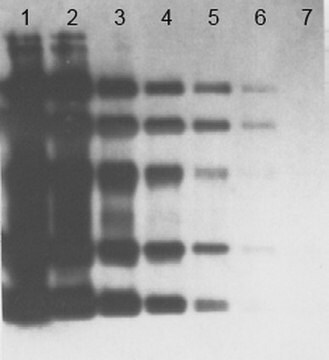S7450-M
OxyIHC Oxidative Stress Detection Kit
The OxyIHC Oxidative Stress Detection Kit contains the chemical & immunological reagents necessary to detect protein oxidation in various tissues from a variety of organs & animal species.
Synonym(e):
Oxidative Stress Assay Kit
About This Item
Empfohlene Produkte
Qualitätsniveau
Hersteller/Markenname
OxyIHC
Methode(n)
immunohistochemistry: suitable
Nachweisverfahren
colorimetric
Allgemeine Beschreibung
apoptosis, aging, neurodegenerative diseases, chronic inflammatory diseases, pulmonary diseases, and
cardiovascular diseases (for reviews, see ref. 1-4). Living organisms are continually exposed to potentially
harmful oxygen free radicals that are generated thru normal cellular functions as well as from environmental
factors (1, 5-7). Yet, these reactive molecules are mitigated by the presence of antioxidants and therefore
organisms exist with a delicate balance between oxidants and antioxidants (7-9). During times of oxidative
stress there is an imbalance in favor of the oxidants. The end result of which is that free radicals are able to
attack and modify sub-cellular components including nucleic acids, lipids and proteins (7, 10-12).
Proteins are one of the major targets of reactive species. Oxidation of proteins modifies the side chains of
methionine, histidine, and tyrosine and forms cysteine disulfide bonds (16-19). Metal catalyzed oxidation of
proteins introduces carbonyl groups (aldehydes and ketones) at lysine, arginine, proline or threonine
residues in a site-specific manner (16, 20-22). The oxidative modification of proteins can modulate
biochemical characteristics of proteins such as enzymatic activity (21-23), DNA binding activities of
transcription factors (24-26), and the susceptibility to proteolytic degradation (12, 25-28). While a
relationship between protein oxidation and aging has been suggested (29-31), little is known about the
importance of oxidative modification of individual proteins in the pathophysiology of free radical mediated
processes. Not surprisingly, carbonyl modification of proteins has become a key biomarker for the
identification of oxidative stress.
necessary to detect protein oxidation in various tissues from a variety of organs and animal species. The
OxyIHC test method involves chemical derivatization of protein carbonyl groups with 2,4-
dinitrophenylhydrazine (DNPH). This chemical reaction results in proteins being covalently coupled to DNP
at their carbonyl sites. The DNP-derivatized proteins are then detected using an antibody that specifically
binds to the DNP moiety. Subsequent incubation with biotin conjugated secondary antibody, streptavidin
conjugated HRP, and development using a 3,3’ diaminobenzidine (DAB) staining allows
immunohistochemical detection of protein oxidation.
Anwendung
Apoptose & Krebs
Neurowissenschaft
Neurodegenerative Krankheiten
Komponenten
10X Antigen Retrieval Buffer, One 1.25 mL bottle
5X Blocking Buffer, One 2.5 mL bottle
Primary Antibody, One 125 mL vial
DAB-A, One 500 mL vial
DAB-B, One 12 mL bottle
Antibody Diluent, One ready to use 12.5 mL bottle
Biotinylated Secondary Antibody, One ready to use 12.5 mL bottle
Streptavidin conjugated HRP, One ready to use 12.5 mL bottle
Hematoxylin, One ready to use 12.5 mL bottle
DNPH Solution, One ready to use 12.5 mL bottle
Derivatization Control Solution, One ready to use 12.5 mL bottle
Lagerung und Haltbarkeit
date of receipt if stored and handled properly.
Haftungsausschluss
Signalwort
Danger
Gefahreneinstufungen
Acute Tox. 4 Oral - Aquatic Chronic 2 - Carc. 1B - Eye Irrit. 2 - Met. Corr. 1 - Muta. 2 - Skin Irrit. 2 - Skin Sens. 1 - STOT RE 2 Oral
Zielorgane
Kidney
Lagerklassenschlüssel
6.1D - Non-combustible, acute toxic Cat.3 / toxic hazardous materials or hazardous materials causing chronic effects
WGK
WGK 3
Flammpunkt (°F)
Not applicable
Flammpunkt (°C)
Not applicable
Analysenzertifikate (COA)
Suchen Sie nach Analysenzertifikate (COA), indem Sie die Lot-/Chargennummer des Produkts eingeben. Lot- und Chargennummern sind auf dem Produktetikett hinter den Wörtern ‘Lot’ oder ‘Batch’ (Lot oder Charge) zu finden.
Besitzen Sie dieses Produkt bereits?
In der Dokumentenbibliothek finden Sie die Dokumentation zu den Produkten, die Sie kürzlich erworben haben.
Unser Team von Wissenschaftlern verfügt über Erfahrung in allen Forschungsbereichen einschließlich Life Science, Materialwissenschaften, chemischer Synthese, Chromatographie, Analytik und vielen mehr..
Setzen Sie sich mit dem technischen Dienst in Verbindung.





